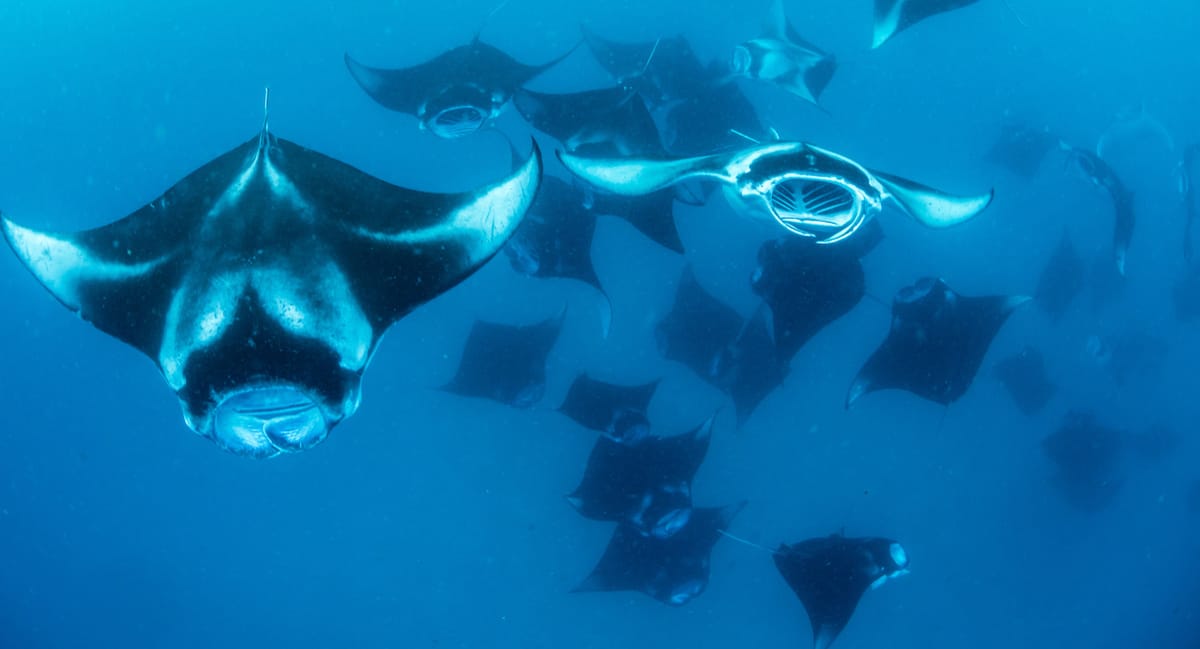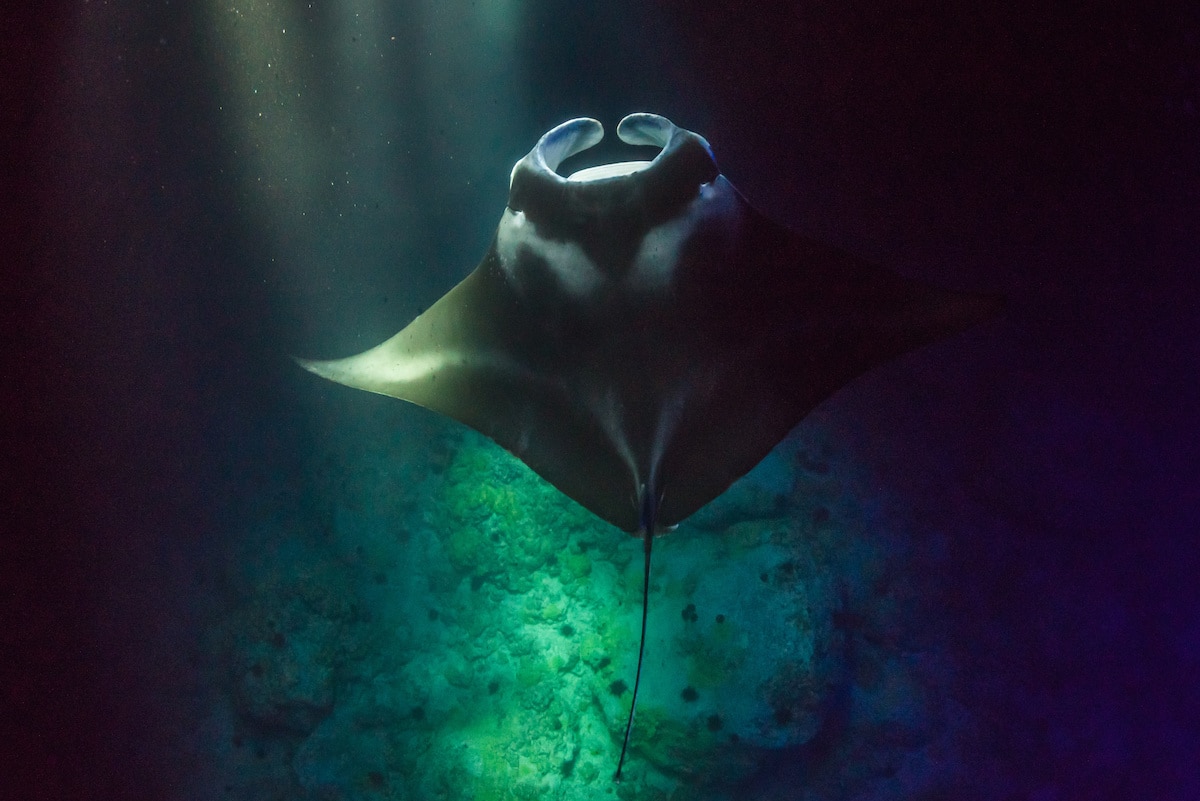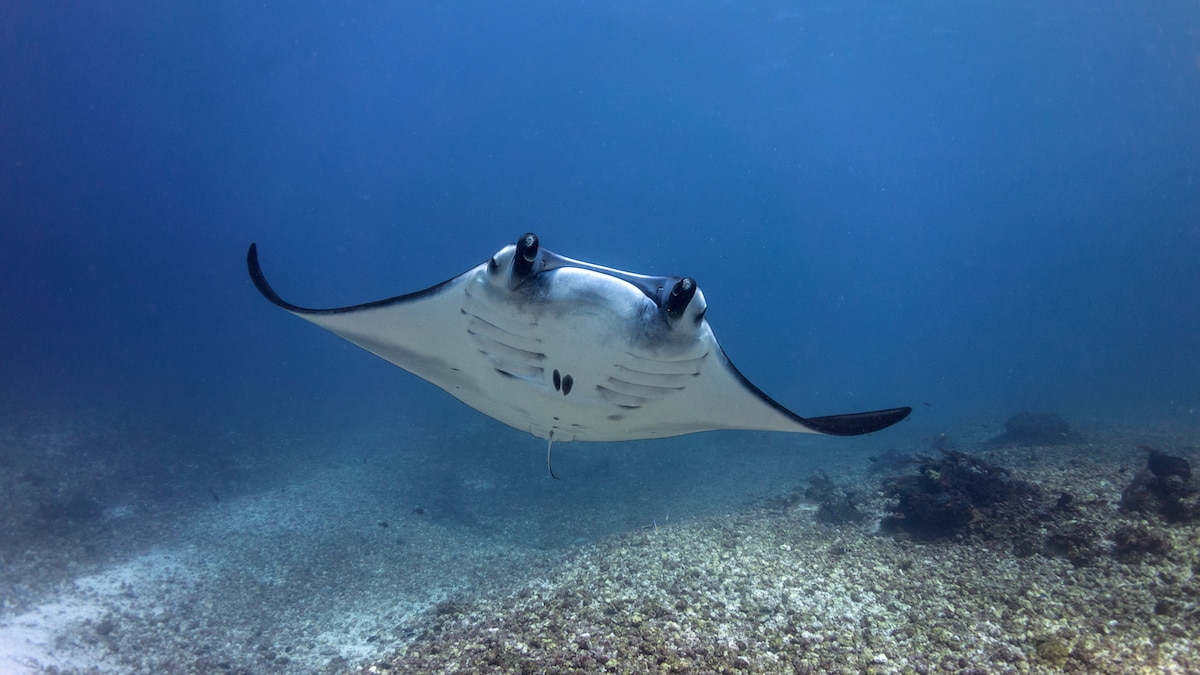News
16 Top Places to Dive with Manta Rays

These is nothing quite as magical as spending time in the water with manta rays. These graceful creatures can be found at top dive destinations around the world and charm many divers every year. Read on for our top 16 liveaboard diving destinations where you can encounter these magnificent ocean giants.
Baa Atoll, Maldives
Baa Atoll is the place to go in the Maldives to swim with hundreds of feeding mantas. One of the Northern Atolls, Baa Atoll is famous for encounters with groups of mantas as they feed on seasonal plankton blooms in Hanifaru Bay.
The mantas funnel plankton within this small, enclosed bay in huge groups; swirling and barrel rolling as they feed. You can watch from your boat or go snorkelling with them.
When to go for mantas: May to November
Liveaboard: The Blue Voyager offers unique Manta Trust expeditions, during which you can swim with mantas and participate in research and conservation activities.
Rasdhoo Atoll, Maldives
Tiny Rasdhoo Atoll has just 4 islands and 3 sandbanks but there is plenty of marine life to find there. Manta Block is one of the best dive sites for spotting manta rays at their cleaning stations. You can also find mantas at Madifaru; a horseshoe-shaped reef teeming with diverse marine life.
Remember to leave time to go in search of hammerhead sharks at Hammerhead Point whilst you’re in the area.
When to go for mantas: November to April
Liveaboard: The Emperor Serenity offers Maldives safaris that include Rasdhoo Atoll and South Ari Atoll.
Southern Ari Atoll, Maldives
Ari Atoll is a classic Maldives dive destination made up of over 100 islands, with numerous submerged pinnacles busy with mantas. The most dependable dive sites for mantas are in southern Ari Atoll, with cleaning stations at Kudarah Thila and Rangali Madivaru.
When to go for mantas: January to April
Liveaboard: The Emperor Virgo offers Pelagic Magic safaris that focus on mantas and whale sharks in Ari Atoll.
Fiji
Fiji might be best-known for its exceptionally colourful coral reefs but there are abundant mantas to find there. The Yasawa Islands have mantas, including at Naviti Island’s coral-covered walls. For numerous mantas, Barefoot Island just south of the Yasawas is a popular choice.
You can also snorkel or dive with mantas at Kadavu, Namena Marine Reserve and Tavenui.
When to go for mantas: June to October
Liveaboard: The Nai’i offers small-group Fiji diving safaris and is one of the few liveaboards that operates there.
Kona, Hawaii
Another much-loved manta destination, Hawaii offers dramatic diving amidst lava landscapes and unique manta night dives. You can go night diving or snorkelling with mantas at Kona and this dive is regularly offered as part of liveaboard diving safaris.

Take a good torch and your camera, then watch the mantas as they barrel-roll and feed in the light.
When to go for mantas: All year
Liveaboard: The Kona Aggressor II offers Hawaii dive safaris.
Socorro Islands, Mexico
If you want to go diving with huge oceanic mantas, you need to go diving at Mexico’s Socorro Islands. This remote destination can only be reached by liveaboard and offers the chance to dive with the world’s friendliest manta rays. These enormous mantas congregate at San Benedicto Island and use the cleaning stations found there.
Being tolerant of divers, they come close and offer fantastic photographic opportunities. Keep an eye out for bottlenose dolphins whilst you dive at Socorro – they are known for mimicking the mantas and divers movements.
When to go for mantas: November to May
Liveaboard: The Valentina offers 10-day Socorro Islands safaris.
Komodo, Indonesia
Indonesia is a great destination for manta ray encounters and Komodo is top of our list. Manta Alley has up to 50 mantas at any one time. You can also find them at Makassar reef, Batu Balong and Golden Passage.
Wherever you go in search of mantas in Komodo you’ll be surrounded by an abundance of other marine life; from tiny critters through to Mola mola, sharks, eagle rays and dolphins.
When to go for mantas: December or February for peak manta numbers.
Liveaboard: The Mikumba II offers barefoot luxury Komodo cruises and is a great option for food-lovers.
Raja Ampat, Indonesia
One of the best dive destinations in Indonesia (and the world), Raja Ampat doesn’t disappoint with its mantas. It is one of the only places in the world where you can see both reef and oceanic mantas.
Manta Ridge and Manta Sandy both host reef mantas, whilst Blue Magic is visited by oceanic manta rays. To see both species together, make sure you dive Magic Mountain.
When to go for mantas: December to March for peak manta numbers.
Liveaboard: The Kurabesi caters for just 12 guests and offers intimate Raja Ampat safaris.
Bali, Indonesia
For the chance to see both mantas and Mola mola, go scuba diving at Nusa Penida, Bali. This laid-back destination has numerous mantas all year, at sites such as Manta Bay and Manta Point.
You can also find Mola mola at Crystal Bay in Nusa Penida. As one of the few places in the world you can find these strange-looking fish, it is unmissable.
When to go for mantas: August to September to see both mantas and Mola mola.
Liveaboard: The Tiare offers cruises that include Nusa Penida.
Koh Bon, Thailand
Koh Bon and the Similan Islands are the jewels in the crown of Thailand’s Andaman diving scene. They are also great dive destinations for mantas.
Koh Bon has numerous mantas, reef sharks and good macro life. Meanwhile, the Similan Islands showcases some of Thailand’s best marine life – including manta rays at Boulder City and whale sharks.
When to go for mantas: Late February for manta rays and whale sharks at the Similan Islands.
Liveaboard: The Junk offers Andaman dive safaris to Koh Bon, the Similan Islands and the nearby Surin Islands.
Great Barrier Reef, Australia
You can see mantas throughout the Great Barrier Reef and they are known to cruise along the continental shelf at the Far Northern reefs.
Lady Elliot Island is also a well-known manta hotspot with hundreds of mantas. This special island is an easy addition to your Australian dive adventure.
When to go for mantas: May and June for peak manta numbers.
Liveaboard: The Spoilsport offers Far North Coral Sea Exploratory safaris.
Ningaloo Reef, Australia
Head to Australia’s northwestern coast and you can go diving off the Ningaloo Coast, a UNESCO-listed World Heritage area. There are plenty of whale sharks to be found at Ningaloo Reef, Australia’s largest fringing coral reef. Few people also realise Ningaloo Reef is busy with mantas, especially at Coral Bay.
When to go for mantas: May to October
Liveaboard: The Shore Thing catamaran offers small-group dive and snorkelling safaris at Ningaloo Reef.
Cabo Marshall, Galapagos
The Galapagos Islands feature at the top of many divers wish lists. Go Galapagos diving and you can see huge schools of hammerhead sharks, plus whale sharks, silky sharks, Galapagos sharks and more.
Did we mention the mantas? You can find plenty of giant mantas at the Galapagos Islands. Hotspots include the famed Wolf and Darwin Islands, Cousins Rock and Cabo Marshall. Cabo Marshall is visited by numerous mantas searching for food and cleaning stations. You can also spot mobula and cow-nose rays there.
When to go for mantas: December to May
Liveaboard: The Nortada liveaboard is ideal for exploring the Galapagos Islands without crowds of divers; catering to 12 guests maximum.
Palau, Micronesia
Palau is less well-known than other places for manta rays but it is one of the most reliable places for manta sightings. Palau’s German Channel has extremely swift currents but the dive site is at the southwest mouth and is one of the best dive sites for experiencing manta rays.
There are manta ray cleaning stations to enjoy and other marine life includes schools of blacktip reef sharks, grey reef sharks, barracuda and numerous tropical fish.
When to go for mantas: October to May
Liveaboard: The Solitude One offers budget-conscious Palau dive safaris.
Tuamotu Archipelago, French Polynesia
Rangiroa and Fakarava atolls are paradise; both above and below the water. These idyllic atolls attract an array of pelagics, including ‘walls of grey reef sharks’, humpback whales, dolphins and mantas.
Don’t miss them if you’re looking for a far-flung destination and peaceful diving.
When to go for mantas: August to October for mantas and humpbacks.
Liveaboard: The French Polynesia Master offers safaris to both Rangiroa and Fakarava.
Donsol, Philippines
Have you heard of Donsol yet? This Philippine dive area is known for its abundant whale sharks and lush volcanic landscapes. Manta Bowl is washed by plankton-rich waters that also attract manta rays to this aptly-named dive site. If you’re lucky, you might even see thresher or hammerhead sharks whilst diving there.
When to go for mantas: November to June for whale sharks and mantas.
Liveaboard: The luxurious Philippine Siren offers Malapascua and Donsol safaris. Just remember to book early as this is one of the most popular liveaboards out there.
This article was written by divers and writers at LiveAboard.com
Gear News
Introducing the TR-80, IR-50 and CS-30 Regulators from DYNAMICNORD

Whether you are a beginner or a professional diver – with the three new main regulators from DYNAMICNORD, everyone will find their favourite regulator. They all look super stylish.
Excellent performance with the TR-80
Quality and performance are the be-all and end-all for regulators. It is not for nothing that the TR stands for Tec Reg. The innovative design of the TR-80 guarantees absolute reliability – even in ice-cold waters.

Perfect breathing effort at 0.8 J/l / certified for diving in waters below 10 degrees / structural design made of solid brass for best cold protection / membrane-compensated design with dry seal of the first stage / reduced exhalation effort thanks to optimized exhalation membrane and bubble deflector / adjustable Venturi (dive/predive) and adjustment knob for individual inhalation comfort / innovative design of the front cover prevents free-flow in strong currents or when diving with scooters / design made of sandblasted brass, matt chrome finish / 2 HP and 4 LP outlets / mouthpiece made of high-quality, anti-allergic silicone for maximum comfort.


Amazing underwater adventures with the IR-50
The IR-50 is the top regulator for advanced and experienced divers. Natural breathing is the essence of this regulator.

Ideal breathing effort at 0.8 J/l /certified for diving in waters below 10 degrees / compensated membrane / adjustable venturi (dive/predive) and adjustment knob for individual inhalation comfort/ outlet valve and deflector for minimum exhalation effort and reduction of bubbles on the face / design made of sandblasted brass, matt chrome finish / 2 HP and 4 NP outlets / mouthpiece made of high-quality, anti-allergic silicone for maximum comfort.


The Workhorse – our CS-30
For diving centres and diving beginners – the workhorse stands for strong construction, reliability and robustness. Perfect for your training.

Optimal breathing effort at 0.8 J/l /recommended for diving in waters above 10 degrees / non-compensated piston / adjustable venturi (dive/predive) / outlet valve and deflector for minimum exhalation effort and reduction of bubbles on the face / design made of sandblasted brass, matt chrome finish / 1 HP and 3 NP outlets / mouthpiece made of high-quality, anti-allergic silicone for maximum comfort.


Octopus OP-30
The OP-30 is the ideal addition to all DYNAMICNORD regulators. It is identical in construction to the CS-30.

The TR-80, IR-50, CS-30 (DIN & INT) regulators and the Octopus OP-30 are available from DYNAMICNORD dealers and in the online store.
DYNAMICNORD – Your Outdoor Companion.
Marine Life & Conservation
Paul Watson Released as Denmark Blocks Japan’s Extradition Bid

Renowned anti-whaling activist Paul Watson has been released from custody in Greenland after spending five months in detention. Denmark’s Justice Ministry rejected Japan’s request for his extradition, citing insufficient guarantees that his time already served in custody would be credited against any potential sentence.
The 74-year-old Canadian-American was arrested on July 21 in Nuuk, Greenland’s capital, when his ship docked to refuel. His arrest was based on a 2012 Japanese warrant related to a 2010 encounter in Antarctic waters. Japan alleged Watson obstructed operations and caused damage to a whaling research ship during efforts to disrupt illegal whaling. Watson has consistently denied these claims, maintaining his commitment to marine conservation.
Denmark, which oversees extradition matters for Greenland, concluded that while the legal conditions for extradition were met, the lack of assurances from Japan regarding time-served credit made extradition untenable.
In a video shared by his foundation, Watson expressed gratitude and relief, saying, “After five months, it’s good to be out… and good to know they’re not sending me to Japan.” He added that the most difficult part of his time in custody was being separated from his two young sons.
Watson is a pioneering figure in marine conservation, known for founding the Captain Paul Watson Foundation in 2022 after decades of activism with the Sea Shepherd Conservation Society. His bold efforts to defend marine life have earned him widespread support, including from celebrities and conservationists. His work has also been featured in the acclaimed reality TV series Whale Wars.
Watson’s lawyer, Jonas Christoffersen, praised the decision, stating, “We are happy and relieved that Paul Watson is now free.” He added that Watson is eager to reunite with his family and continue his vital work.
The arrest occurred while Watson’s vessel, the M/Y John Paul DeJoria, was en route to the North Pacific with a team of 26 volunteers to intercept a Japanese whaling ship. His foundation described the arrest as politically motivated and emphasized that Watson’s actions were focused on ending illegal whaling practices.
Japan resumed commercial whaling in 2019 after leaving the International Whaling Commission, asserting that whale meat is a cultural tradition. Conservationists, however, continue to challenge these practices, highlighting their impact on marine ecosystems.
Despite the challenges, Watson remains steadfast in his mission to protect marine life and bring attention to whaling practices. His dedication to ocean conservation has made him a globally respected advocate for the environment.
-

 News2 months ago
News2 months agoIconic SS United States to become the World’s Largest Artificial Reef
-

 News3 months ago
News3 months agoBook Review – 52 Assignments: Underwater Photography
-

 Gear News3 months ago
Gear News3 months agoDYNAMICNORD – New German diving brand enters the British market
-

 News3 months ago
News3 months agoExploring Cenote El Pit: A Diver’s Dream
-

 Gear News3 months ago
Gear News3 months agoTry BARE drysuits (and maybe even win one!) this Friday with Sea & Sea at North West Dive Fest
-

 Marine Life & Conservation3 months ago
Marine Life & Conservation3 months agoBook Review: Coral Triangle Cameos
-

 Blogs2 months ago
Blogs2 months agoDive the Egyptian Red Sea this Autumn with Regaldive
-

 News3 months ago
News3 months ago2024 Ocean Art Underwater Photo Competition Announced



















